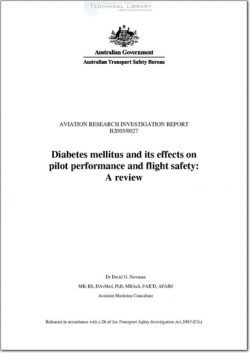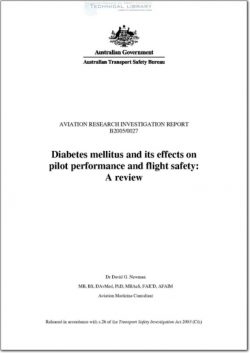ATSB-B2005-0027

- Version
- 201 Downloads
- 307.45 KB File Size
- 1 File Count
- August 9, 2016 Create Date
- August 9, 2016 Last Updated
Diabetes Mellitus and its effects on Pilot Performance and Flight Safety; A Review

Diabetes mellitus is a disease with a wide spectrum of severity and many potential
complications if inadequately treated. These include the risk of hypoglycaemia,
ketoacidotic coma, cardiovascular disease, and kidney, eye and neural disease. The
prevalence of diabetes is increasing both in Australia and around the world, and is
increasing the costs associated with medical care. In Australia, 7.4% of the
population have diabetes, and 16% have impaired glucose metabolism. In 1995, the
health care costs associated with diabetes in Australia were estimated to be
$1 billion.
Historically, diabetic pilots have been permanently disqualified from flying duties.
This policy was based on the increased risk of sudden incapacitation in-flight due to
hypoglycaemia and cardiovascular disease in diabetics. In recent decades, a shift in
worldwide aeromedical policy has occurred. This has resulted in diabetic pilots in
several countries, including the United States and Australia, being granted limited
flying certification. These pilots are required to satisfy a number of stringent
medical criteria to achieve this certification.
Aeromedical policy must be based on an appropriate risk management strategy,
taking into account all relevant issues. Australian guidelines for the certification of
diabetic pilots are designed to limit certification to all but the most well-controlled,
motivated, and well supervised diabetic with no disease-related complications.
Strict adherence to this policy by those involved in the certification process should
ensure the continued safety of all involved in the aviation industry. Ongoing
evaluation of the policy and research into the aviation safety outcomes of diabetic
pilots is recommended.
| File | Action |
|---|---|
| ATSB-B2005-0027 Diabetes Mellitus and its effects on Pilot Performance and Flight Safety; A Review.pdf | Download |

Comment On This Post